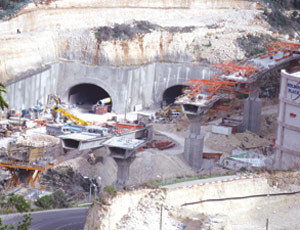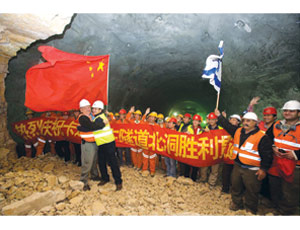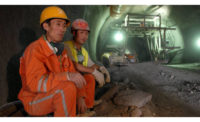The anticipated Nov. 30 opening of Israel’s longest tunnel marks the end of four years of construction and more than a decade of controversy. But completion of the 6.5-kilometer-long Carmel Tunnels, a $300-million build-operate-transfer highway project, will vastly improve traffic flow in the port city of Haifa and is the first major project in Israel for a Chinese contractor.


The project, involving major tunneling work deep below Mount Carmel and the city’s residential neighborhoods, also is the second-largest BOT job in the Middle East, project officials say. The toll route is expected to reduce travel time substantially in and through Haifa, the country’s third-largest city, by steering traffic away from the congested downtown area.
“We expect 40,000 drivers to use the Carmel Tunnels on a daily basis,” predicts Uri Luft, deputy CEO of Carmelton Group Ltd., a joint venture of two Israeli infrastructure contractors: Ashtrom Ltd. and Housing and Construction Holding Co. Ltd. The team won the BOT contract to build the tunnels in 1997, but financing and legal issues delayed work for years.
Engineer WBI, a German specialist in hard-rock construction, designed the project, which includes two sets of twin 10.3-meter-dia tunnels; one is 3.5-km long, and the other is 1.6-km long, with two lanes of traffic. There also are nine precast and cast-in-place concrete bridges, up to 400 m long.
Carmelton awarded China Civil Engineering Construction Corp. (CCECC) the project’s $100-million tunnel-boring contract. “It would have cost us nearly a third more had we selected a European company for the job,” says David Sela, Carmelton chief engineer. “There were substantial differences between the German planners and the Chinese that had to be resolved before the project could actually get under way,” says Carmelton Managing Director Haim Barak. Before the project got under way in 2007, “we had to bridge two cultures that simply don’t share the same work traditions or view of technology,” he adds. The Chinese preferred not to subcontract out concrete work, as is customary in Israel and other Western countries.
But the Israelis hardly were prepared for the equipment and techniques used by the Chinese company. Instead of huge boring machines commonly used in Western projects, CCECC crews worked with handheld drills, small cement mixers and manual cement sprayers. Sela says crews used drill-and-blast methods in the soil, which was mostly hard rock.
CCECC brought in 550 Chinese workers for the project, including laborers and engineers. Crews lived near the building site, and shifts operated 24-7. At any given time, 180 workers were on-site, officials say. The tunnelers worked as deep as 200 m below the surface. “The Chinese averaged 5 to 6 m per day in the sections of dolomite rock and about half that rate in the soft-rock section,” says Sela.
Shortly after tunneling began, the Chinese company asked to bring in an additional 120 workers. But the Israeli Interior Ministry refused to issue visas. Fearing that the timetable would not be met, Carmelton contracted with an Israeli firm to complete 1,000 m of tunneling, using local workers.
Furthermore, Chinese crews went on strike in September 2008—one year after work began—demanding increased payment for tunneling. After a seven-week hiatus, Carmelton agreed to hike CCECC’s fee 10% above the original contracted price. The firm resumed operations and completed its work on schedule in September 2009.
Tunnel completion and opening is five months ahead of the contractual deadline, according to Sela.

